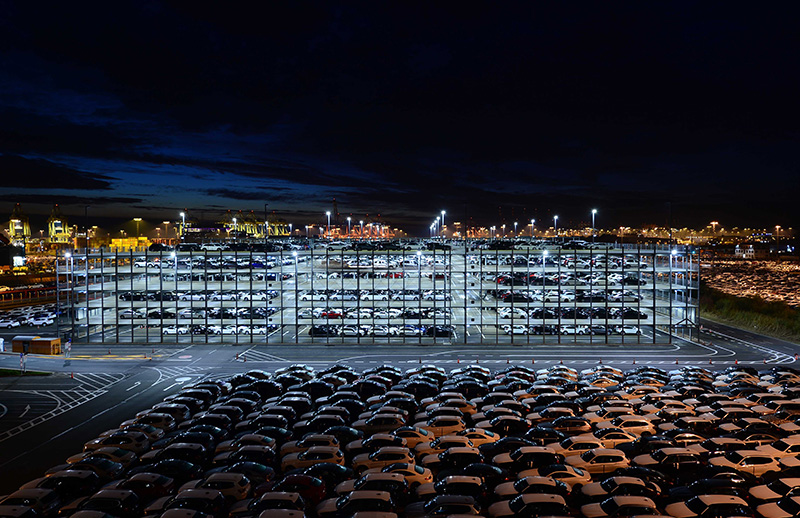 Our 2015 survey finds that, with imports in particular on the rise, some ports have experienced capacity issues despite investments in connectivity, capacity and information technology. Meanwhile, others are suffering as a result of geopolitical and broader economic instability. Contribution by Christopher Ludwig
Our 2015 survey finds that, with imports in particular on the rise, some ports have experienced capacity issues despite investments in connectivity, capacity and information technology. Meanwhile, others are suffering as a result of geopolitical and broader economic instability. Contribution by Christopher Ludwig
Across the European continent last year, from Scandinavia to Turkey, from the Mediterranean to the English Channel, the trade of new light vehicles across major ports rose, highlighting the recovery of vehicle demand in the region that started to take hold more than two years ago. Across 41 ports that reported new vehicle statistics to Finished Vehicle Logistics in our annual survey, total volume (including transhipment) rose by nearly 10% to above 20.5m units compared to the same ports in 2014, an increase of around 1.9m units.

Of those ports surveyed, imports rose most significantly, climbing 14.1% to 8.79m units, supported by the growth in sales across many European Union and EFTA markets, which stood at 9.3% in 2015, reaching 13.7m units. Exports, which had been the dominant growth and volume driver for many ports, especially in northern Europe and Spain, were still strong, rising by 6.8% to 11.71m in the survey. However, this growth was driven in part by internal demand within Europe, as well as by exports to North America; exports to China, on the other hand, saw broad declines.
While many ports invested in their infrastructure during the decline, the rises have led to some capacity issues, leading terminals to lease temporary space, or some shipping lines to struggle for berths. Short-sea shipping line UECC, for example, experienced infrastructure, space and labour challenges in major ports such as Belgium’s Zeebrugge – which was once again the largest in Europe – Germany’s Bremerhaven, in the UK at Southampton, as well as at the northern French port of Le Havre.
“The biggest struggle has been at the port of Southampton, which has insufficient berth space and land space. Furthermore, cruise season is coming, which will make it worse,” points out Bjorn Svenningsen, head of sales and marketing at UECC.
More investment may well be needed as forecasts are for continued growth or stability in most cases, although notable exceptions are north African and Russian ports, where political or economic strife point to continued declines in volume.
 Click to enlarge
Click to enlargeSuch divides reflect Europe’s contradictions between growth and risk. While the local market is generally in recovery, including nearly double-digit growth across major markets in the early months of 2016, plenty of tensions remain. Years of austerity and economic decline have taken their toll, while the continent struggles to deal with a multitude of crises on its external borders, especially from the Middle East, where hundreds of thousands of refugees continue to seek passage to Europe. This issue, together with recent terrorist attacks in western Europe, Turkey and elsewhere, have threatened the border-free Schengen zone. Russia’s political and economic problems have also taken a hard toll on European exports.
Also looming is uncertainty over a British referendum on its membership of the EU; an ‘out’ vote would undoubtedly send economic shockwaves through the bloc, and raise questions over Britain’s important vehicle trade with mainland Europe.
Nevertheless, Europe’s industry is by-and-large healthy, and its ports, shipping lines and terminal operators are investing in capacity and services. The low price of oil has also helped contain operating costs. While 2015 was once predicted to bring a huge rise in fuel prices because of new regulations on low sulphur fuel, lower bunker costs have largely mitigated this. The future may be tough to predict, but logistics providers are broadly optimistic about their prospects.
Southern standoutsOf the ports that provided figures, 30 posted gains, with all the major countries increasing. There were a number of standout performers, especially in southern Europe. At the port of Civitavecchia, close to Rome, whose figures ranged between 33,000 and 40,000 units from 2012 to 2014, volume grew to more than 176,500 new vehicles last year, including an explosion in exports to more than 100,000 units.
The rise was thanks to the Grimaldi Group opening a new service at the port to North America, which includes exports of the Italian-built Jeep Renegade and Fiat 500x. Other Italian ports also experienced notable growth, including an 87,000-unit rise for Livorno thanks to a strong Italian market recovery. Grimaldi Lines also increased its sailings to Spain and Sicily.
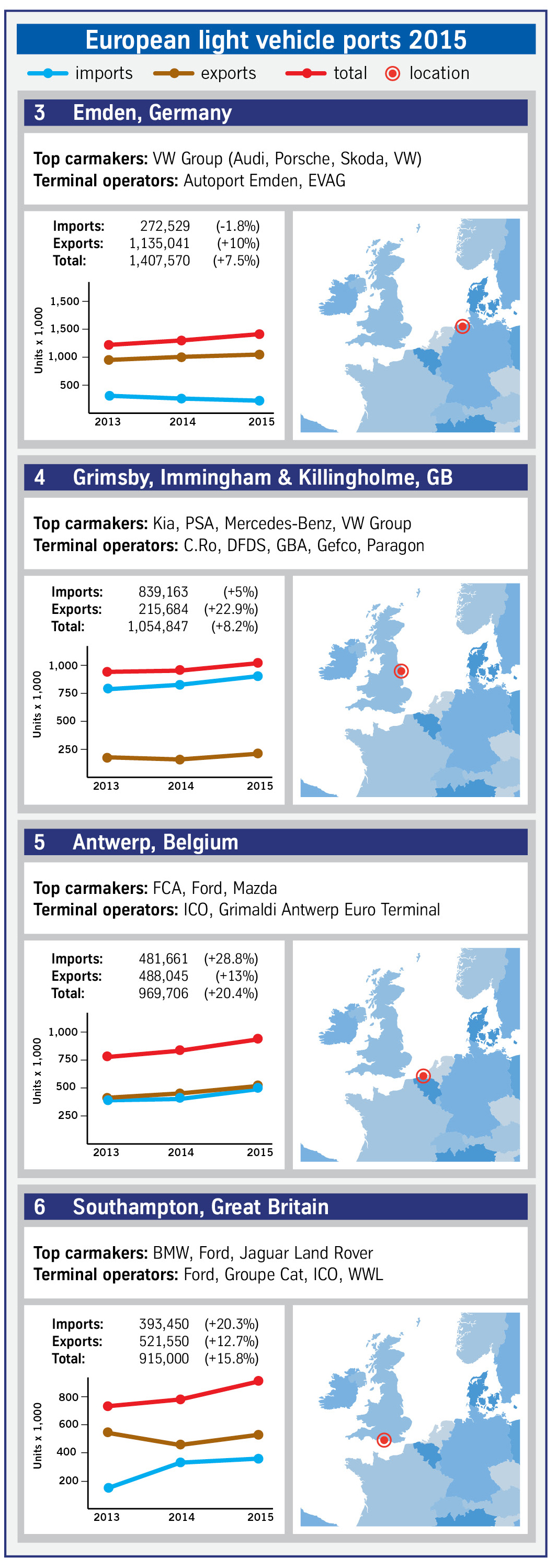 Click to enlarge
Click to enlargeHowever, it was Spain’s ports that saw the biggest increase by country, with an increase of nearly 25% reported across five ports to more than 2.6m units, including increases of 35% and 45% at Barcelona and Valencia respectively. Notably, Spain’s ports saw jumps in both exports, as Spanish production increased, and in imports as the domestic market finally gained momentum, with local sales growing by more than 20%. Spanish ports are thus seeing strong investment, with particular emphasis on improving rail capacity and access.
At Barcelona, volume rose by more than 230,000 to 881,000 units, including a doubling of imports. Lluis Paris, commercial manager, says that the port is working to improve distribution to southern and central Europe from eastern Asia and north Africa (notably from the Renault Nissan plant in Tangiers, Morocco). It is also positioning itself as a suitable port for exporting European production to Asia.
Barcelona has thus been expanding capacity, and recently assigned two new deep-sea berths and one short-sea berth to car traffic. “We maintain a 24-hectare surface contiguous to the car terminals in order to accommodate growth,” says Paris. “Here, we improved the rail tracks. At the end of 2015, we completed the first improvement phase and can now operate three trains simultaneously. The tracks can handle trains in the Spanish, standard UIC and metric gauges. We are now lengthening these 600-metre tracks to 750 metres in order to handle longer trains.”
At the port of Valencia, the volume of new vehicles in 2015 was the highest in its history, reaching 607,000 units compared to 417,000 the previous year. Jorge Civera Perez, head of technical sales, says the main contributor to this growth has been the increase of export volumes by more than 45% compared to 2014. Ford’s plant in Almussafes, 20km from the port, experienced the greatest export increase.Because of the need for space, Valencia awarded a concession for a 50,000 sq.m facility and is in the process of awarding another 100,000 sq.m. With the offer of a 30% rebate for using rail, the possibility of transporting new vehicles by rail to Valencia is boosting this traffic for brands such as Opel, Renault and Iveco, according to Perez.
The port of Santander also reached a record in exports and in total vehicles handled with more than 454,000 units compared to 372,000 in 2014. “Improved management of our railway infrastructure between the port and car factories, such as Renault, means that we are now operating a 600-metre length train on a daily basis. Our medium-term goal is for a 750-metre minimum length,” says Cristina Lopez Arias, general manager. The port has launched a fourth railway line dedicated to car loading and unloading. It also introduced a new lighting system in the rail terminal at night, according to Lopez Arias.
The port of Vigo experienced some volume increases, although its growth was relatively flat last year, hurt in particular by a drop in exports to the once booming Algerian market. For Vigo, this volume has fallen to about one-third of its 2013 level, according to commercial manager Dolores Rois Orza. UECC’s Svenningsen says new safety regulations for imports to Algeria have dried up the market almost completely, leading the shipping line to suspend its service to the port of Djen Djen.
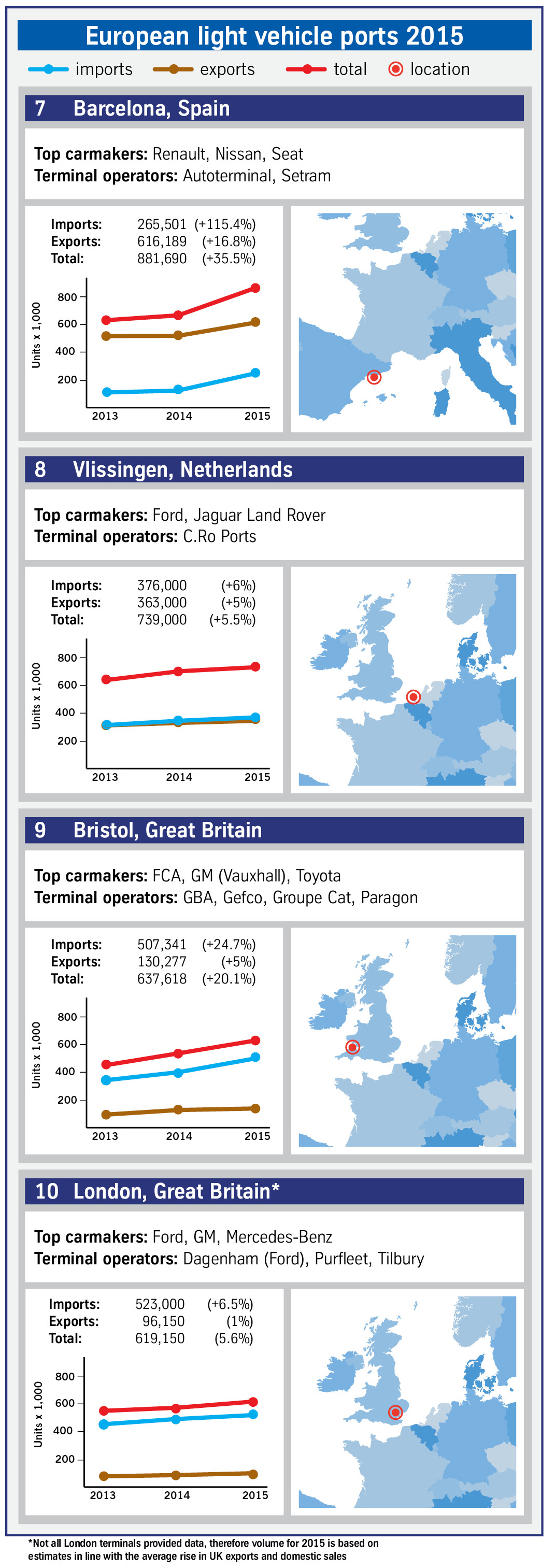 Click to enlarge
Click to enlargeWhile Vigo has suffered from declines to north Africa, shipments to the UK, France, Germany, Turkey and Italy continue to grow. Recent developments at the port, which is located close to an important PSA plant, include increased connections with France thanks to the establishment of a short-sea route between Vigo and Nantes-St. Nazaire. Vigo also added a new floating ramp to the previous five fixed ones, designed to compensate for the tidal range while embarking and disembarking and mainly devoted to truck cargo.
In neighbouring Portugal, the port of Setubal also saw recovery, as imports increased by 37.5% to more than 83,000 units, pushing the port’s total to more than 171,000 units. Joao Goncalves, of the commercial and marketing division, says that at the end of 2015, the port completed the Coelho da Mota RoRo Terminal’s expansion, an investment of €2.9m ($3.23m) that enables it to provide valued-added services on vehicle exports and imports that are currently provided at logistics parks outside the port.
“Our goal is to create an intercontinental, cross-trade, ro-ro link between the Atlantic, Africa and Asia trade lanes and Mediterranean lines, as well as offer vehicle distribution to Portugal and Spain as far as Madrid,” he says.
Among the port’s recent developments, Volkswagen’s AutoEuropa plant extended its terminal concession by 15 years, according to Goncalves. The port serves six regular lines, including three for Grimaldi Lines and one each for Volkswagen Group Logistics, NYK and EML, with connections to Asia and North America.
Benefits of BeneluxThe port of Zeebrugge was again Europe’s largest new-vehicle handler last year. Setting another record of nearly 2.43m units, up from 2.2m the previous year, it led the way for double-digit growth across terminals in Belgium and the Netherlands. The port of Antwerp also experienced a significant volume increase, handling nearly 970,000 units compared to 806,000 in 2014. Ann De Smet, business development coordinator at Antwerp, says that although its exports to China declined, this was more than made up for by imports from Mexico and North America. Further expansion at the port is underway.
“The opening of the Kieldrecht Lock on the left bank of the port, where the ro-ro terminals are situated, will offer a second access to that port area and smoother transit for the most modern ro-ro vessels,” says De Smet.
In the Netherlands, although it suffered a drop in volume last year (partly because it changed its methodology for calculating statistics), the port of Rotterdam has started to see the impacts from the recent acquisition of its car terminal by shipping and logistics provider C.Ro Automotive, according to Sjors Bosvelt, general manager at C.Ro Automotive at the port. “This followed a high peak at the end of 2015. Because of the takeover by C.Ro Ports from Broekman Automotive, we benefit from synergies that the group provides in Europe with our terminals and CLdN’s short-sea vessels,” he says.
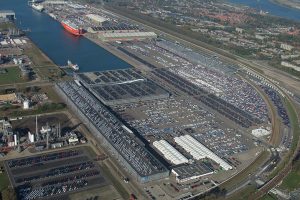 Sjors Bosvelt says that the takeover of Rotterdam’s car terminal by C.Ro Ports from Broekman Automotive has created synergies across the combined group's terminals and CLdN’s short-sea vessels
Sjors Bosvelt says that the takeover of Rotterdam’s car terminal by C.Ro Ports from Broekman Automotive has created synergies across the combined group's terminals and CLdN’s short-sea vesselsCldN, a ro-ro operator in the group, plans to double the capacity of its entire fleet, which will also require the Rotterdam terminal to double its handling capacity. Bosvelt says the port is preparing to invest in a rail terminal with four 750-metre tracks and an extra jetty for additional berths. “We are targeting Germany and eastern Europe for export to the UK, and we expect a modal shift from truck to rail,” he says.
The port of Amsterdam, meanwhile, handled nearly 285,000 units last year, up from 199,000 in 2014. Anthony van der Hoest, cluster manager for logistics, says that last year, the port began building a new lock at an investment of $1 billion, which will open by 2019.
In January, Koopman Car Terminal opened a back-up terminal at Amsterdam, which is also handling new Nissan and Infiniti cars. Its first terminal remains multipurpose and accounts for approximately 50% of total business. The new terminal, located in close proximity, has more or less the same capacity, offering 20,000 spaces. The original terminal continues PDI and modification and will open a new high-tech, osmosis-based car wash in April that can handle over 400 cars per day – twice the capacity of the previous one, according to Lou Jedeloo, managing director of the firm’s car terminal and international business.
Dutch and Belgian ports also benefitted from shifts at the Volkswagen Group, says Jiri Cee, head of Skoda brand logistics, which combines its outbound flows with Volkswagen Group Logistics. “We can maximise the synergy effects from the cooperation of more brands,” says Cee. “Other factors influence our choice of particular ports, such as capacity possibilities, availability of ship owners and price.”
Cee points to examples that include switching deep-sea shipments to Colombia from Bremerhaven to the Dutch port of Vlissingen. For Australia and New Zealand, the group also changed from Bremerhaven to Zeebrugge. “This has provided greater efficiency for the whole transport chain, resulting in the reduction of delivery time and increased economic benefits. Our port strategy will continue to be determined in close cooperation with VW Group Logistics,” adds Cee.
A change of dynamics in GermanyThe port of Bremerhaven, which battles with Zeebrugge for the top spot in Europe, posted a relatively small gain of 3% last year to reach more than 2.26m units. However, whereas in years past the port has been propelled by strong export growth to markets such as China, last year saw something of a reversal, with a large expansion in the port’s import volume, which nearly doubled, and a decline of around 11% in exports.
Wolfgang Stöver, director of marketing and sales at BLG AutoTerminal Bremerhaven, says this year, BLG is expecting volumes of the same level as 2015. The weak Russian market continues to be a drag on exports, while last year, Daimler started to use the port of Koper, Slovenia to export to Asia, switching from northern European ports like Bremerhaven. “We lost about 100,000 units of Daimler annually to the port of Koper, although total Daimler exports are [overall] up a bit. The aim of the port switch is to save transit time from [Mercedes-Benz’s] southern plants,” says Stöver.
Also likely to impact exports is a decline in Volkswagen exports following fallout from its emissions scandal, although the carmaker’s exports were stable in 2015. “We have not seen much effect from the ‘Dieselgate’ scandal because orders were placed before it happened,” says Stöver.
The strength of the US market continues to be a boon for German exports, and while the Chinese market has seen a decline in imports, German-built volumes are still strong. Likewise, Bremerhaven has benefitted from imports from German plants abroad, including in the US, South Africa and other European locations.
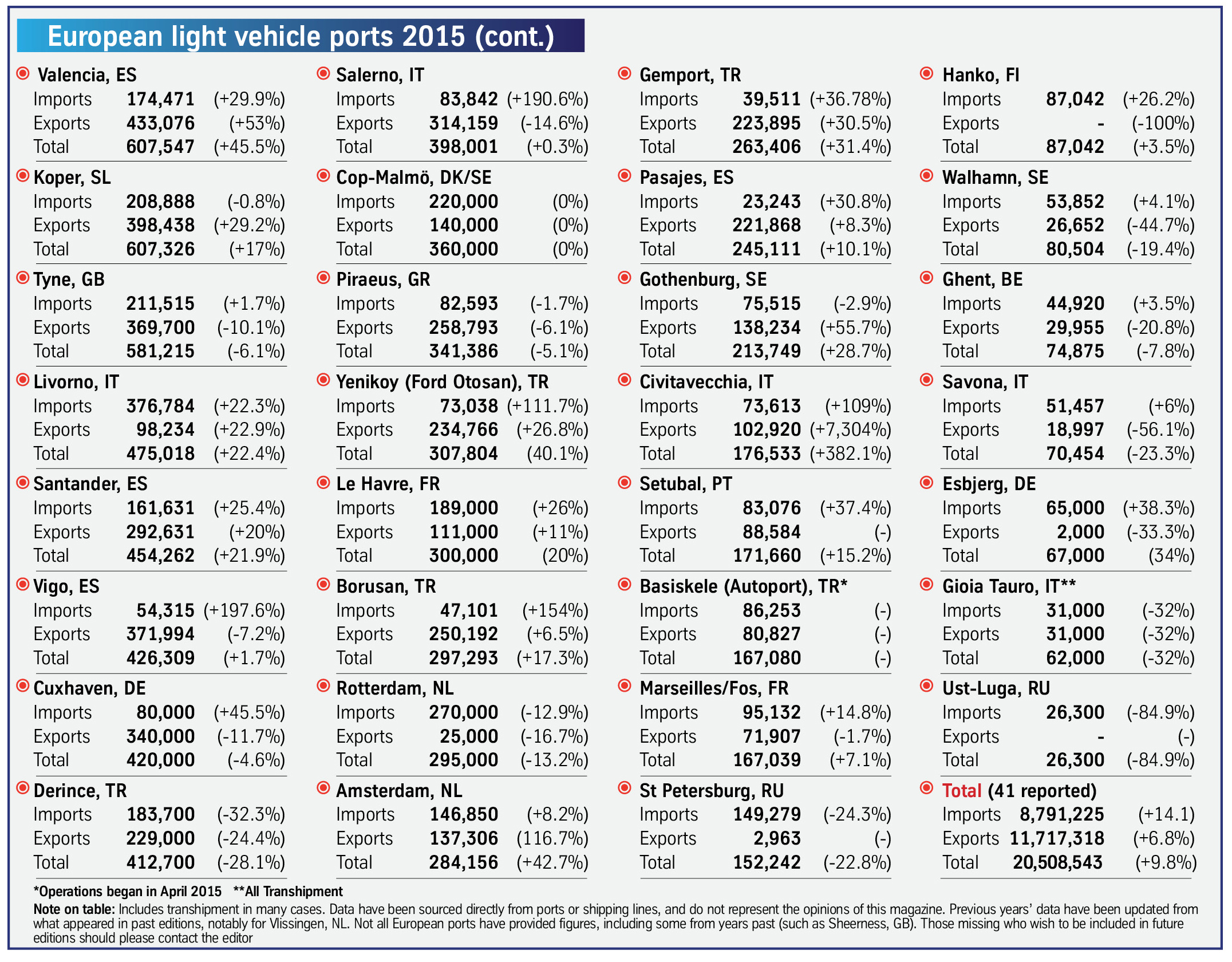 Click to enlarge
Click to enlargeFor example, Mercedes-Benz increased exports at the same time as it did imports from the US and South Africa last year. Mercedes imports also picked up substantially from Finland, with shipments of the A-Class from contract manufacturer Valmet. As a result, BLG saw capacity issues at peak times, and needed more space. Initially, it used the neighbouring BLG Container Terminal; last October, BLG opened a new car park that handles between 6,000 and 7,000 units, bringing the total to 96,000. BLG is also expanding its rail infrastructure both outside and inside its terminal. In October, it began expanding its on-terminal rail connection from eight to 16 tracks. Two marshalling yards are also under construction outside, which will further improve rail efficiency.
Europe’s third-ranked port of Emden, the major export centre for the Volkswagen Group, handled about 1.4m units last year, an increase of 100,000 units. Although the port will see impacts from declines in Volkswagen sales, Emden anticipates handling similar volumes in 2016 as last year, according to Jörg Tuitjer, head of operations at terminal operator EVAG. Indeed, Emden is forecast to handle about 1.7m vehicles per year by 2020, including some growth likely to be driven by imports, including from Audi’s upcoming factory in San José Chiapa, Mexico.
“In the last few years, our import volume has been slightly sinking, whereas the export volume is still rising. We will be receiving the Audi Q5 from Mexico, which should be a significant volume,” notes Tuitjer.
In anticipation of further growth, a new berth opened at Emden in December 2015 for short-sea traffic, intended particularly for trade between the UK and Portugal with Germany, according to Tuitjer.
Daimler’s answer in the AdriaticAs indicated by Stöver at the port of Bremerhaven, one of the most significant developments in European vehicle shipping last year was Daimler choosing Slovenia’s Koper as its Mediterranean hub, shifting exports from northern European ports for vehicles it builds in southern plants that are destined for Asia. The purpose was mainly to reduce inland transit time from plants, as well as offer opportunities to shorten shipping routes between Europe and Asia. Shipments started moving through the port towards the end of the year.
Alexander Koesling, head of supply chain management for Mercedes-Benz Cars, said in a Daimler press release that Koper offers cost-effective and flexible shipping options from Europe to Asia. It also provides a significant reduction in carbon emissions because of reduced transit times by land and especially by sea. After Bremerhaven and Zeebrugge, Koper is now the carmaker’s third most important European hub for overseas exports. The latter now handles exports from Mercedes-Benz plants in Sindelfingen and Rastatt, Germany; from the Magna Steyr plant in Graz, Austria; from Kecskemet, Hungary; as well as the smart production plants in Hambach, France and Novo Mesto, Slovenia. Transferring freight via Koper can reduce transit times by up to one week, according to Daimler.
But the move to Koper faces some logistical challenges. The rail link to the port is single-tracked at points and several times this year construction work on the route has forced Daimler to divert volume back to Bremerhaven.
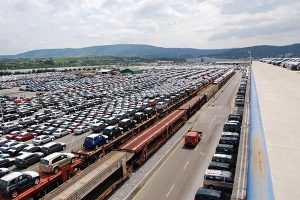 Exports are up at the port of Koper, but restrictions on its rail connection have resulted in diversions by some carmakers to other ports
Exports are up at the port of Koper, but restrictions on its rail connection have resulted in diversions by some carmakers to other portsNevertheless, the Daimler move is part of an important increase in exports at Koper compared to imports. “A couple of years ago, our import-export ratio was 70:30; last year, it was 35:65,” says car terminal director Gregor Belic. While Belic expects Daimler to become Koper’s largest exporter this year, the port also handles important exports from Volkswagen. Hyundai Glovis has also started using Koper to export Hyundai and Kia models built in central Europe to Spain.
Koper now offers regular services to Singapore, Brunei, and China, and to Tarragona, Spain, and has also increased exports to Turkey and Israel. Trade has declined, meanwhile, with other markets in north Africa and the Middle East.
The port has consolidated several parking areas for more optimal car warehousing. It added 4,500 more spaces within the past six months, and new areas are currently under development. It will also build four new rail tracks for its car terminal and will add a new berth, set to open in 2017. Belic says the next step is to consolidate a new line for east Asia with imports to Koper.
Expanding British capacityThe UK continued its growth for vehicle shipping and port handling in 2015. Although one significant import port, Sheerness, declined to provide data this year, those that did showed a rise of nearly 9% in volume, remaining close to Germany in terms of overall volumes. The combined volumes across Humber ports, including Grimsby, Immingham and Killingholme, surpassed 1m units for the first time. Investment continued across a range of terminals here, notably Kia’s recently opened centre with Paragon near Grimsby.
Southampton, the most important port for deep-sea vehicle trade in the UK, handled about 915,000 vehicles, a roughly 9% increase from its 2014 volume. Port manager Clive Thomas expects 2016 volume to rise by a further 9-10%. For exports, customers include Jaguar Land Rover, Honda and Rolls-Royce, as well as JCB and Case New Holland on the high-and-heavy side. On the import side, Southampton handles Ford, which has a terminal at the port, Renault, and both German and US-built BMW models.
“Following investment of £1.2m ($1.7m) in an upgrade to our eastern dock rail infrastructure, we currently handle five automotive trains daily,” says Thomas. “We invested £10m on our sixth multi-deck to enhance our eastern dock storage capacity by an additional 3,000 parking spaces for export storage. In the western docks, we have an additional 12 acres (4.8 hectares) of car storage that accommodates 2,500 import vehicles.”
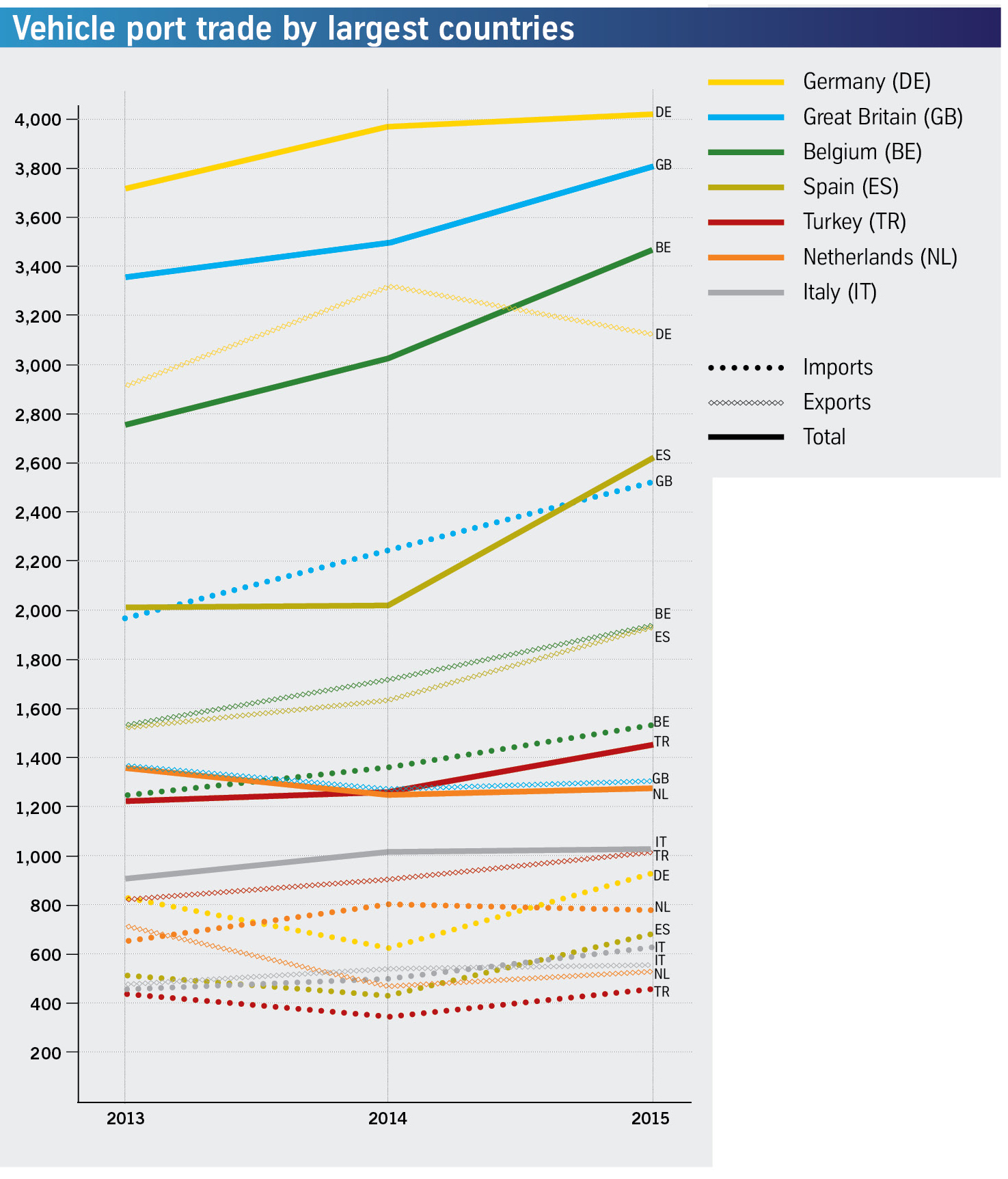 Click to enlarge
Click to enlargeAcross the port, Southampton will invest £20m into additional multi-storey car parking and a new link span for stern-ramp ro-ro vessels; in the eastern docks, it plans to remodel its berths to ensure accommodation of the largest quarter ramps.
The port of Bristol, in the west of England, experienced significant growth in exports, as well as a rise of more than 20% in imports thanks to the strong market in the UK. In particular, deep-sea shipping from east Asia and with Mexico increased, according to Tony Dent, director of automotive trade. The port reported more than 637,000 units handled last year, up from 507,000 in 2014.
At the port of Tyne, near Newcastle in north-east England, overall volumes declined as the nearby Nissan plant in Sunderland dropped in production (in part because of preparation for new models). However, the port experienced large volumes of stock vehicles shipped to the UK, which resulted in Tyne expanding its car storage space, including extra land for the Volkswagen Group. Tyne also worked with Nissan and invested over £2m in expanding the Tyne Car Terminal by ten acres. The port has furthermore seen an increase in high-and-heavy volumes and project cargo, including Hitachi rail carriages from Japan for its manufacturing plant in Newton Aycliffe.
Volatility in TurkeyOverall, Turkish ports saw gains of around 16% in 2015, however the expansion masked volatility across the region because of political and economic developments, not least Turkey’s role in the crisis across the Middle East, and later in the year its conflict with Russia over shooting down one of its fighter jets, which led Russia to restrict Turkish imports.
Among Turkey’s ocean carriers is the Cenk Group, which provides liner services between Turkey, Ukraine and Romania. The cargo flow is also bound for Russia and eastern European countries such as Belarus – which moves mostly through the port of Ilychevsk, Ukraine, according to marketing manager Serkan Zembilli. “During the past two to three years, political issues including the Syrian civil war that started in 2011, the conflict between Ukraine and Russia since 2014, and the conflict between Turkey and Russia since last year, have severely reduced our volumes,” he says.
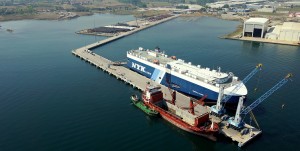 After fee increases at the port of Derince in Turkey, some shipping lines diverted calls to Autoport, which reopened last year
After fee increases at the port of Derince in Turkey, some shipping lines diverted calls to Autoport, which reopened last yearNonetheless, Turkey’s sales and production have grown and are expected to rise further, and internal competition between Turkey’s regional ports has intensified. The most complicated development has been at the port of Derince, where the Cenk Group had previously been a terminal operator and stevedore. Last year, following a long-term plan by the government to privatise Derince, Safi Group won the bid and took over the port to handle all terminal and stevedoring operations. According to Zembilli, the port also increased tariffs by 300%, which led carriers to divert to other ports. Cenk, for example, is now using ports such as Efesan and Autoport, which is located near Derince.
The Safi Group has said that the increases at Derince reflected fees for services that the government didn’t provide and which carriers would have paid for separately; they also took into account overtime fees. In October last year, however, it announced a revision of its fees and plans to expand its ro-ro business, though it is not clear yet if this will encourage shipping lines and carmakers back to the port.
Sources in Turkey say that most of Derince’s traffic shifted to the Autoport terminal following the changes last year. Autoport, which had first opened in 2008 prior to the financial crisis and later suspended operations, reopened last year with renewed dedication to the sector.
UECC was among those carriers that moved from the port of Derince to Autoport. According to Bjorn Svenningsen, the result was better handling quality and infrastructure, more experienced management, and shorter turnaround time for its vessels in Autoport.
Complexity at the bordersRussian port volumes continued to decline in 2015 following a drop in new vehicle sales of 36% in Russia compared to 2014, and the third straight year of falling sales. At logistics provider Russian Transport Lines, which operates terminals at the port of St Petersburg and Ust-Luga, chairman Konstantin Skovoroda says the market remains under great pressure, with Russian consumers moving even further away from vehicle imports.
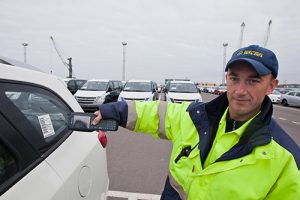 The forecast is for a continued fall for Russian ports like Ust-Luga and St Petersburg, as a weak rouble causes imports to drop further
The forecast is for a continued fall for Russian ports like Ust-Luga and St Petersburg, as a weak rouble causes imports to drop further“Our forecast is for a continued decline in imports. Because the rouble’s exchange rate is falling, import costs have become a great challenge for both OEMs and importers,” he says. “Importers with rouble income are trying to minimise their expenditures and consequently do not support the OEMs’ growth plans.”
Skovoroda anticipates further consolidation of ports called by shipping lines, as well as of terminal volumes. On the bright side, he points to opportunities for Russian-based carmakers and for ports in St Petersburg to export vehicles. Some carmakers, including Hyundai Motor, have already started to increase shipments to other markets, however the adjustment to build export models at Russian plants is not one that can happen overnight.
The European economy remains complex, with evident risks in the greater region. Global slowdowns in trade and global markets are a threat to the continent’s strong vehicle exports. However, despite the risks, the region’s port landscape has a positive outlook for trade and economic growth. Continued development in infrastructure is a preview of expansion plans for most ports – from rail connectivity to berth and storage capacity and information technology advances. Though they may be shaken further by the Middle East crisis, a possible ‘Brexit’, or problems with Russia, European ports are preparing for the tides of volume to rise higher.
Topics
- Africa
- africa
- Asia
- asia
- Asia Pacific
- Asia Pacific
- Benelux
- europe
- Europe
- Exports
- features
- Finished vehicles
- Germany
- Germany
- Imports
- Middle East
- middle east
- Middle East and Africa
- Nissan
- north america
- North America
- Port processing
- Ports/terminals
- Ro-ro
- Shipping
- Shipping - vehicles
- South America
- south america
- South America
- Spain
- Spain
- UK


























![Global[1]](https://d3n5uof8vony13.cloudfront.net/Pictures/web/a/d/s/global1_726550.svgz)









